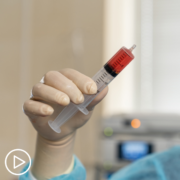What Is the Role of Bone Marrow Biopsies in AML Treatment?
What Is the Role of Bone Marrow Biopsies in AML Treatment? from Patient Empowerment Network on Vimeo.
What part do bone marrow biopsies play in acute myeloid leukemia (AML) treatment? Expert Dr. Andrew Hantel from Dana-Farber Cancer Institute and Harvard Medical School discusses the value and information gained from bone marrow biopsies, how AML characteristics can vary, and his hopes for the future of bone marrow biopsies.
Download Resource Guide | Descargar guía de recursos
Related Resources:

How Bone Marrow Biopsies Impact Acute Myeloid Leukemia Treatment and Care |

Do AML Bone Marrow Biopsies Show Racial and Ethnic Variances? |

|
Transcript:
Lisa Hatfield:
Dr. Hantel, can you explain the importance in utility of bone marrow biopsy as it relates to treatment?
Dr. Andrew Hantel:
Yeah, so bone marrow biopsies are one of the mainstays of our ability to understand where somebody’s leukemia is. And what I mean by that is somebody’s leukemia can be newly diagnosed, and we need to get a lot of the information about it. It can be somebody who’s after treatment, and we need to understand if their leukemia has responded to that treatment.
And that can take the form of, did the treatment work well enough to clear out all of the leukemia cells? And also after somebody’s blood counts have come back after the treatment has been completed, are only their good blood cells back, or has the kind of leukemia not responded adequately to treatment? And relative to the normal tubes of blood that we can get quite easily, a bone marrow biopsy, which we don’t like to do unless it’s necessary, is something where we have a lot of additional information that we can obtain. And it’s both information that we can’t obtain from the blood and also kind of information that we can get to kind of a different degree of specificity than we can in the blood.
And so a little bit more specifically, what I mean by that is sometimes people’s blood counts will look relatively okay, and there can be a good amount of leukemia still in their bone marrow. And other times, the person’s leukemia can be in remission, but their blood counts can look low and abnormal.
And so we need to be able to tell which of those things is actually happening. And if we could tell that without doing bone marrow biopsies, we would do that every time. But, unfortunately, the bone marrow is kind of a little bit of a harbor compared to the bloodstream. And so to be able to actually look and see what’s happening kind of in the factory is really necessary. And there’s a lot of additional tests that we’re able to run, because that’s where kind of the cells are produced, and we can see at a much lower level if there’s are any hints of leukemia left.
There’s more and more interest in kind of getting good testing from the blood. And so that’s a very active area of investigation. And to be able to do that in the future, I really hope there’s a day where we don’t have to do bone marrow biopsies. But for right now, our only ability to tell how well we’re doing with somebody’s leukemia treatment is to be able to…it’s to do bone marrow biopsies and obtain kind of that really granular specific and kind of deep dive detail.










